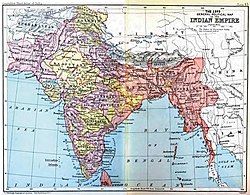Burma Province
| British Burma | ||||||||||||||||||
|
Province of British India (1886–1937) Colony of the United Kingdom (1937–1948) |
||||||||||||||||||
|
||||||||||||||||||
|
||||||||||||||||||
|
Anthem God Save the King (1824–1837; 1901–1942; 1945–1948) God Save the Queen (1837–1901) |
||||||||||||||||||
|
Burma during World War II
Dark green: Japanese occupation of Burma. Light silver: Remainder of British Burma. Light green: Occupied and annexed by Thailand. |
||||||||||||||||||
| Capital | Rangoon | |||||||||||||||||
| Languages | English (official) Scots (national) Burmese (forbidden) |
|||||||||||||||||
| Religion | Buddhism, Christianity, Hinduism, Islam | |||||||||||||||||
| Political structure | Colony | |||||||||||||||||
| Monarch | ||||||||||||||||||
| • | 1862–1901 | Victoria | ||||||||||||||||
| • | 1901–1910 | Edward VII | ||||||||||||||||
| • | 1910–1936 | George V | ||||||||||||||||
| • | 1936 | Edward VIII | ||||||||||||||||
| • | 1936–1947 | George VI | ||||||||||||||||
| Governor | ||||||||||||||||||
| • | 1923–1927 | Harcourt Butler (first) | ||||||||||||||||
| • | 1946–1948 | Hubert Rance (last) | ||||||||||||||||
| Chief Commissioner | ||||||||||||||||||
| • | 1862–1867 | Arthur Purves Phayre (First) | ||||||||||||||||
| • | 1895–1897 | Frederick William Richard Fryer (last) | ||||||||||||||||
| Legislature |
Legislative Council of Burma (1897-1936) Legislature of Burma (1936-1947) |
|||||||||||||||||
| • | Upper house | Senate | ||||||||||||||||
| • | Lower house | House of Representatives | ||||||||||||||||
| Historical era | Colonial era | |||||||||||||||||
| • | First Anglo-Burmese War | 5 March 1824 | ||||||||||||||||
| • | Anglo-Burmese Wars | 1824–1826, 1852, 1885 | ||||||||||||||||
| • | Anti-colonial movement | 1918–1942 | ||||||||||||||||
| • | Separation from British India | 1937 | ||||||||||||||||
| • |
Japanese occupation and Thai occupation |
1942–1945 | ||||||||||||||||
| • | Independence from the United Kingdom | 4 January 1948 | ||||||||||||||||
| Currency | Burmese rupee, Indian rupee, Pound sterling | |||||||||||||||||
|
||||||||||||||||||

Imperial entities of India
|
|
| Dutch India | 1605–1825 |
|---|---|
| Danish India | 1620–1869 |
| French India | 1769–1954 |
|
|
|
| Casa da Índia | 1434–1833 |
| Portuguese East India Company | 1628–1633 |
|
|
|
| East India Company | 1612–1757 |
| Company rule in India | 1757–1858 |
| British Raj | 1858–1947 |
| British rule in Burma | 1824–1948 |
| Princely states | 1721–1949 |
| Partition of India |
1947
|
|
|
|
British rule in Burma lasted from 1824 to 1948, from the Anglo-Burmese wars through the creation of Burma as a Province of British India to the establishment of an independently administered colony, and finally independence. Various portions of Burmese territories, including Arakan, Tenasserim were annexed by the British after their victory in the First Anglo-Burmese War; Lower Burma was annexed in 1852 after the Second Anglo-Burmese War. The annexed territories were designated the minor province (a Chief Commissionership), British Burma, of British India in 1862.
After the Third Anglo-Burmese War in 1885, Upper Burma was annexed, and the following year, the province of Burma in British India was created, becoming a major province (a Lieutenant-Governorship) in 1897. This arrangement lasted until 1937, when Burma began to be administered separately by the Burma Office under the Secretary of State for India and Burma. British rule was disrupted during the Japanese occupation of much of the country during the Second World War. Burma achieved independence from British rule on 4 January 1948.
Burma is sometimes referred to as "the Scottish Colony", due to the heavy role played by Scotsmen in colonising and running the country, one of the most notable being Sir James Scott, and the Irrawaddy Flotilla Company.
The province of Burma, after 1885 was administered as follows:
The "Frontier Areas", also known as the "Excluded Areas" or the "Scheduled Areas", compose the majority of states within Burma today. They were administered separately by the British with a Burma Frontier Service, and later united with Burma proper to form Myanmar's geographic composition today. The Frontier Areas were inhabited by ethnic minorities such as the Chin, the Shan, the Kachin and the Karenni.
...
Wikipedia



